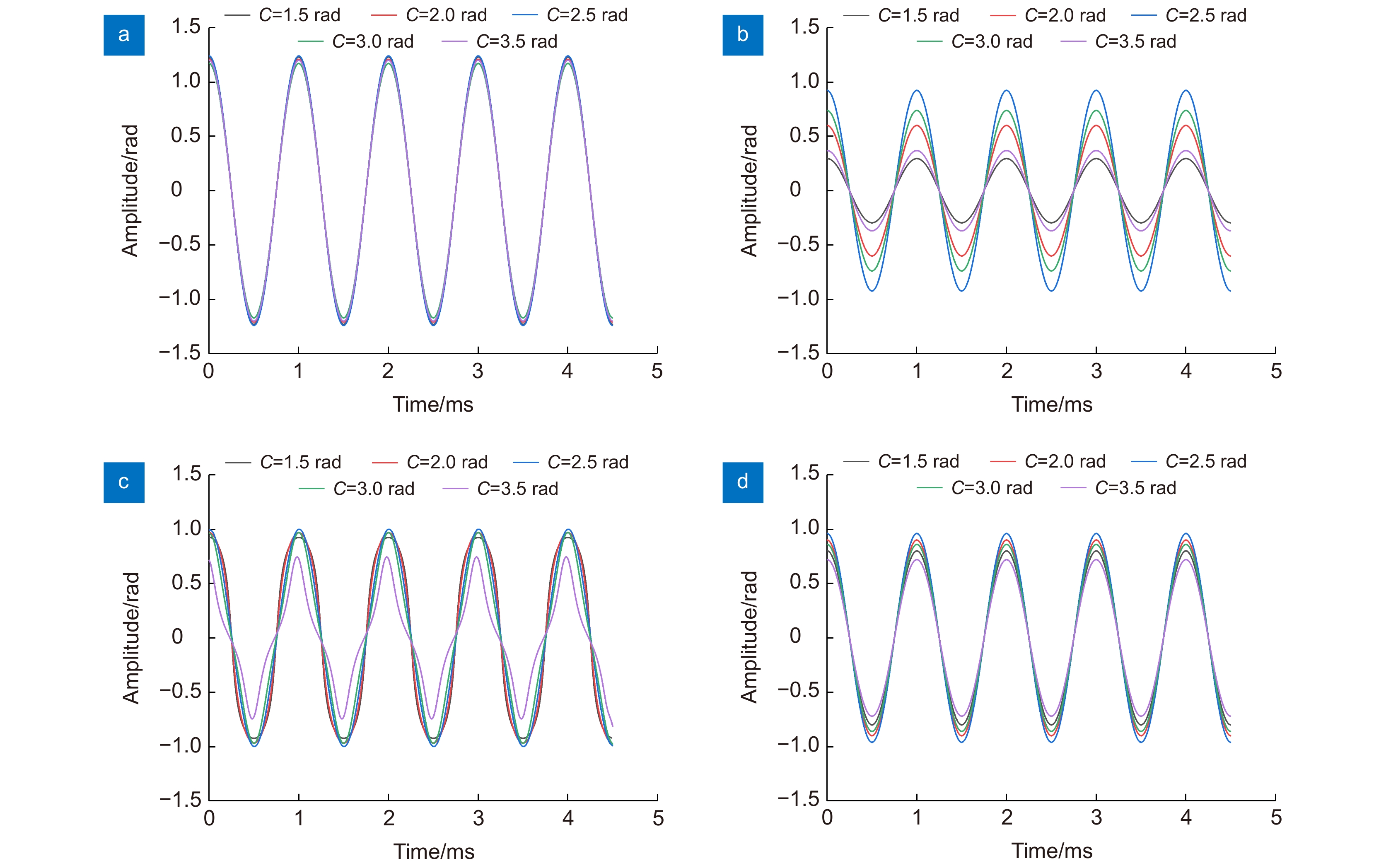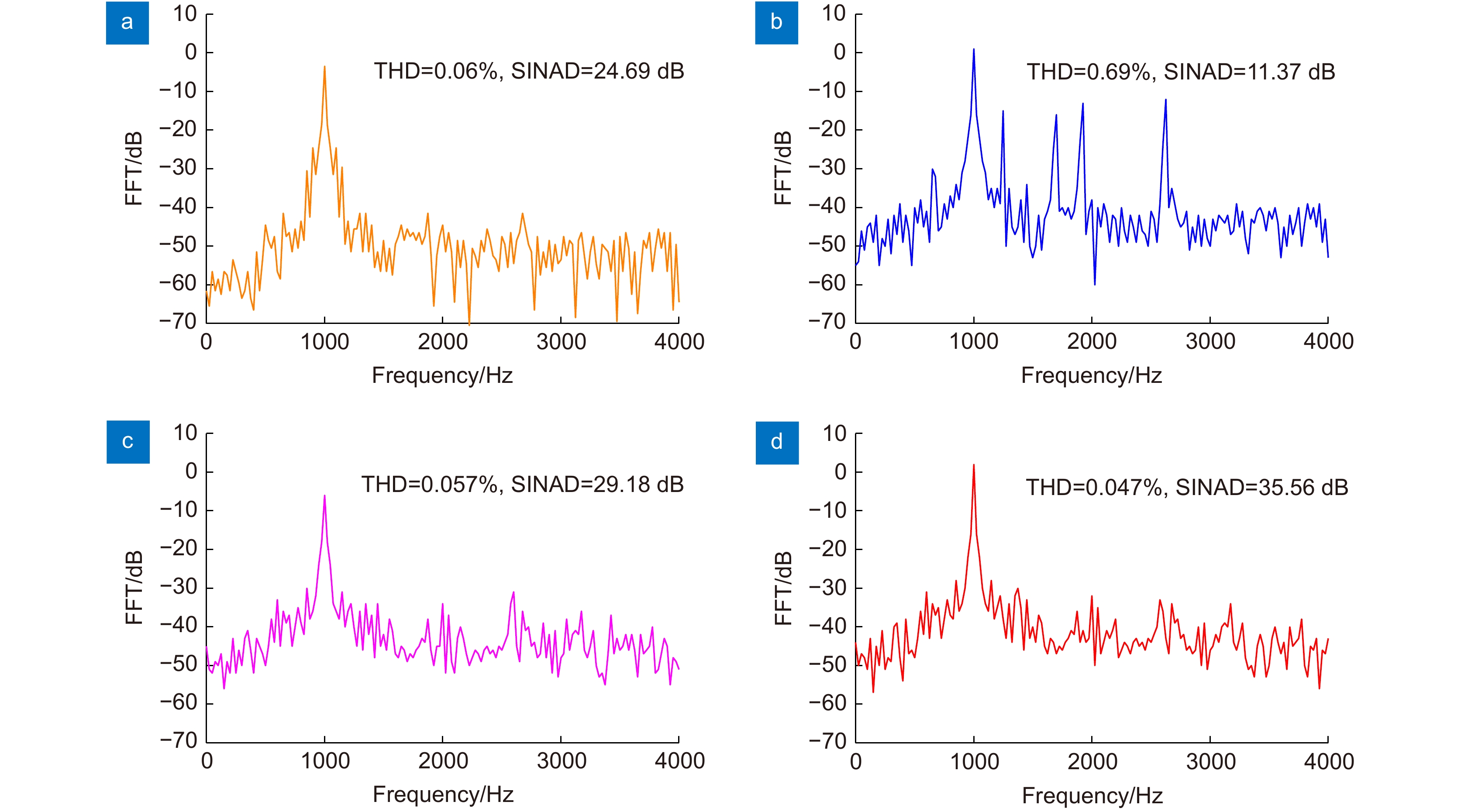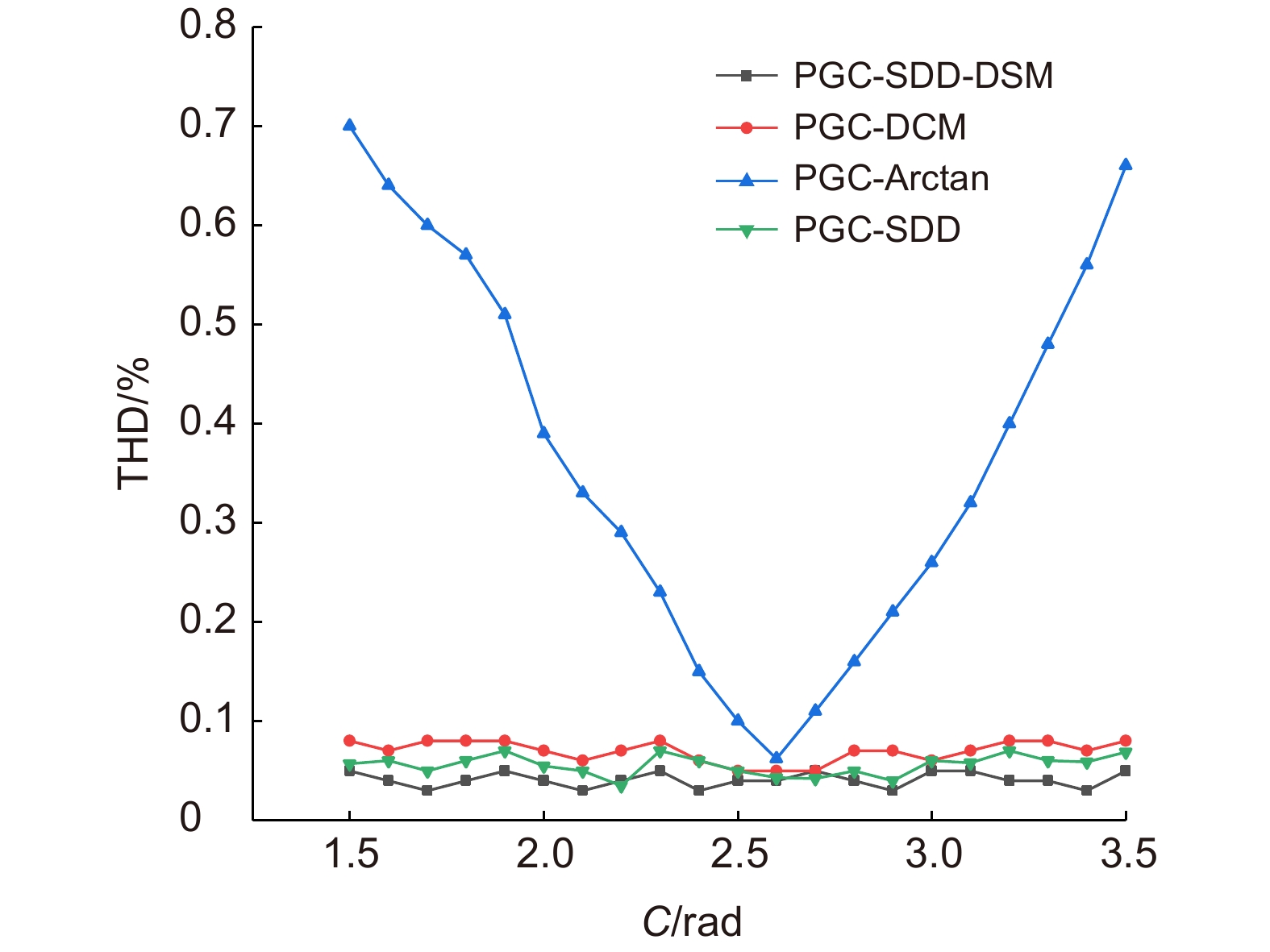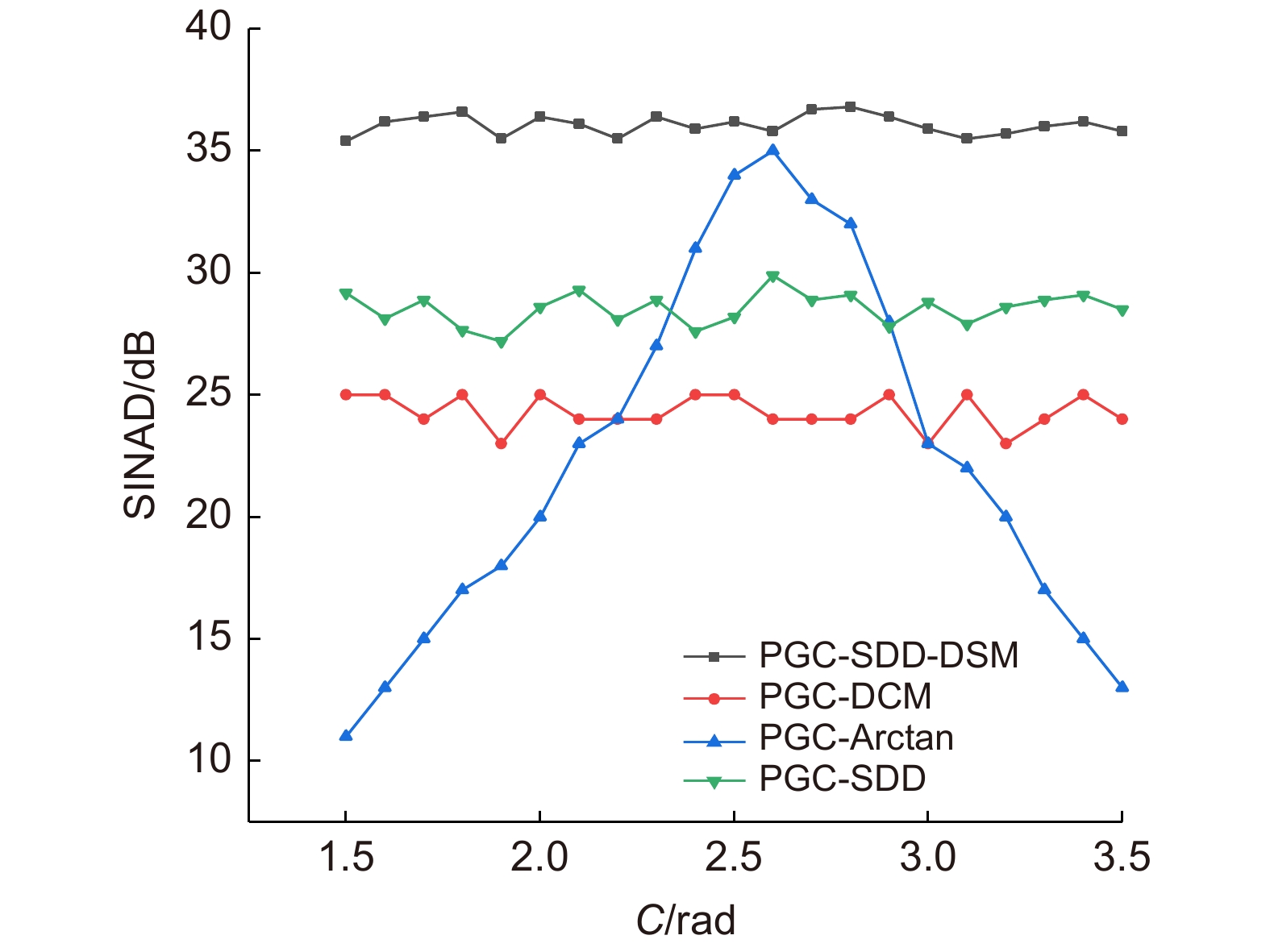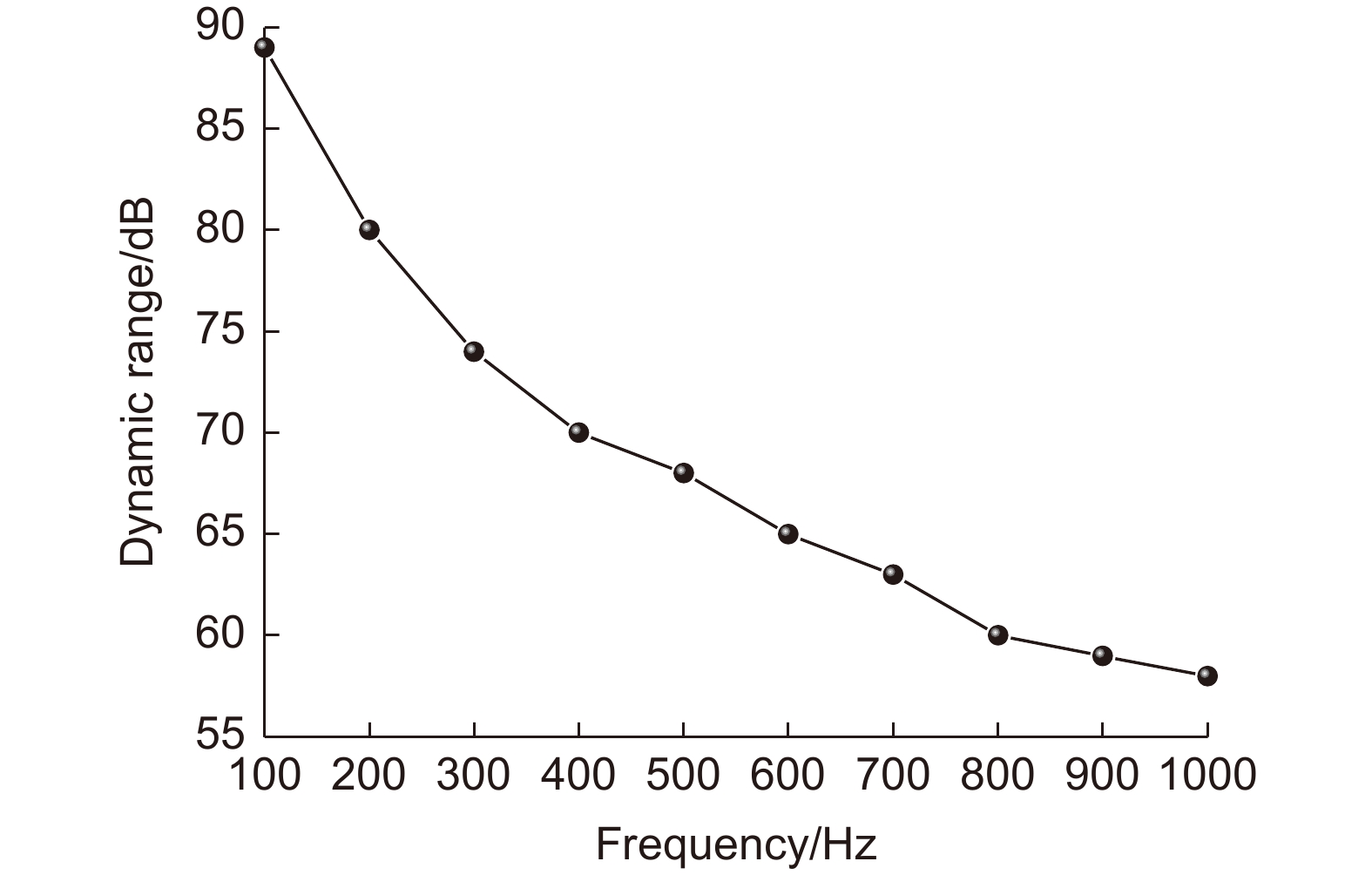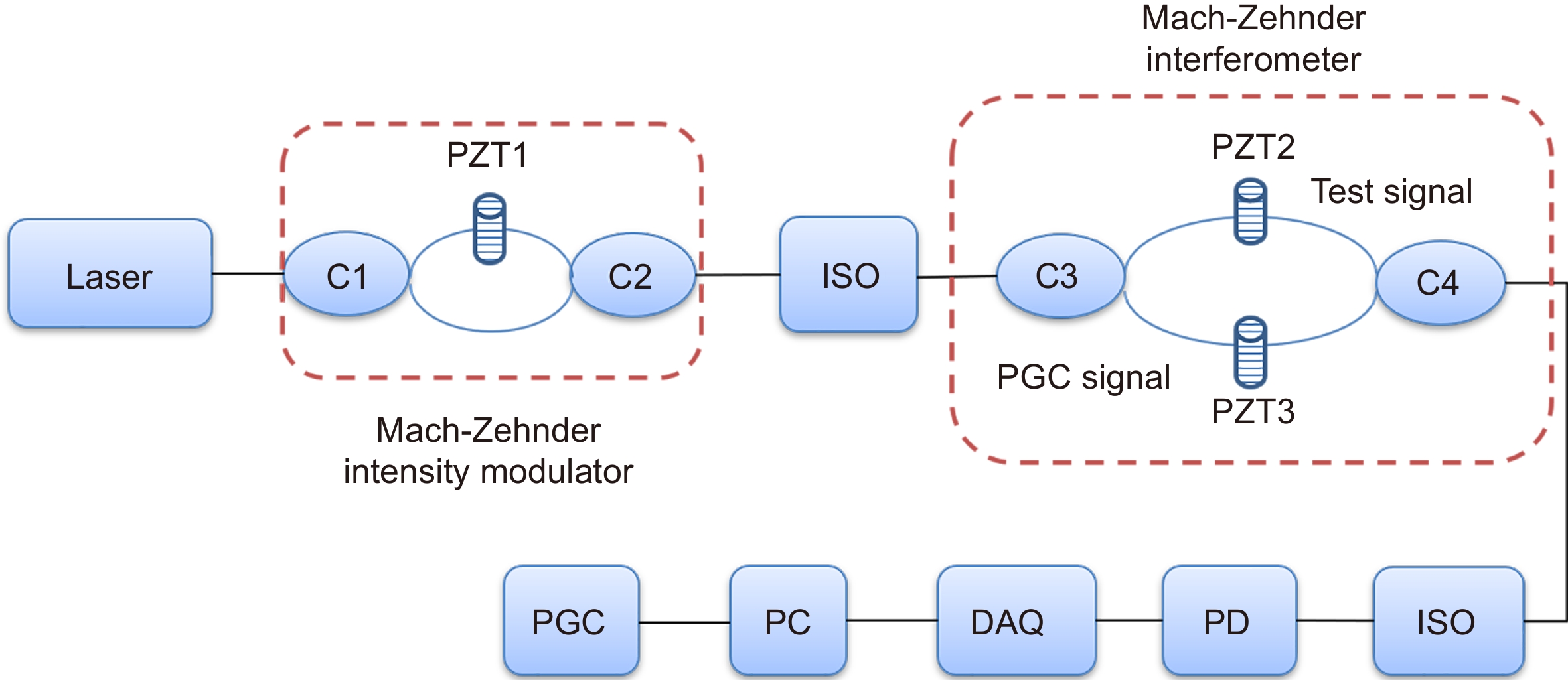-
摘要:
相位生成载波(PGC)解调技术具有高灵敏度、线性度好和动态范围广的优点,因此广泛应用于分布式光纤传感器中。本文提出了一种单路微分相除和微分自相乘的PGC(PGC-SDD-DSM)解调算法,该解调算法对载波相位调制深度和光强度干扰均不敏感。仿真实验显示,与PGC单路微分相除(PGC-SDD)解调算法、传统的PGC微分交叉相乘(PGC-DCM)和PGC反正切(PGC-Arctan)解调算法相比较,改进的PGC解调算法具有最佳的解调效果。将改进的PGC解调算法应用在光纤干涉传感器中,实验结果表明改进的解调算法能有效抑制光强和载波调制深度引起的失真。待测信号的频率为1 kHz,幅度值为2 rad,在引入1.5 rad的载波调制深度和 0.7 rad的光强干扰深度时,实验系统中使用改进PGC解调算法的解调结果信纳比(SINAD)可以达到35.56 dB,与使用传统的PGC-DCM、PGC-Arctan和PGC-SDD解调算法相比较分别高出10.87 dB、24.19 dB和6.38 dB,同时系统的稳定性得到了提升。该技术有效地促进了光纤传感器领域的技术研究。
Abstract:The phase generated carrier (PGC) demodulation technique is widely used in distributed fiber-optic interferometric sensors, for its high sensitivity, good linearity, and large dynamic range. An improved PGC demodulation algorithm with single-path differential divide and the differential-self-multiplication (PGC-SDD-DSM) demodulation algorithm is proposed in this paper, the demodulation result of the PGC-SDD-DSM algorithm is not related to the carrier phase modulation depth (C) and light intensity disturbance (LID). The simulation and experiment results show that the proposed algorithm is insensitive to the C value, and compared with the single-path differential divide to PGC demodulation algorithm (PGC-SDD), the traditional differential-cross-multiplying (PGC-DCM) and PGC Arctangent (PGC-Arctan) demodulation algorithms, and the proposed algorithm has the best demodulation effect. When the proposed demodulation algorithm is applied in the optical fiber interferometric, it is found that the proposed algorithm can suppress the distortion caused by LID and C. The frequency of the signal to be demodulated is 1000 Hz, and the amplitude value is 2 rad. When the carrier modulation depth of 1.5 rad and the light intensity interference depth of 0.7 rad are introduced, the signal-to-noise and distortion ratio (SINAD) of the demodulation result using the improved PGC demodulation algorithm in the experimental system is 35.56 dB, which is 10.87 dB, 24.19 dB, and 6.38 dB higher than using traditional PGC-DCM, PGC-Arctan, and PGC-SDD demodulation algorithms, respectively. It is proved the system's stability improved effectively. This technology effectively promotes technical research in the fields of optical fiber sensors.
-
Overview: Phase generated carrier demodulation is widely used in distributed fiber-optic interferometric sensors. Traditional PGC demodulation methods include the PGC-DCM (differential-cross-multiplying), the PGC-Arctan (PGC Arctangent) demodulation methods, and the PGC-SDD (single-path differential divide) demodulation scheme proposed by previous researchers. While the demodulation results of those demodulation algorithms are influenced by light intensity disturbance or phase modulation depth, which affects the stability of the demodulation system. Here, high stability and low harmonic distortion PGC demodulation technique with single-path differential divide and differential-self-multiplication (PGC-SDD-DSM) is proposed, and the demodulation result of which is not affected by light intensity and C value shift of the phase modulation depth. The simulation results show that when the C value is 1.5 rad, 2.0 rad, 2.5 rad, 3.0 rad, and 3.5 rad, the amplitude of PGC-DCM, PGC-Arctan, and PGC-SDD demodulation algorithm changes obviously, while the result of PGC-SDD-DSM demodulation algorithm hardly changes. The improved PGC demodulation algorithm is applied to the experiment system, the system composed of two Mach-Zehnder fiber-optic interference sensors verifies the performance of the proposed PGC demodulation algorithm. The first Mach-Zehnder sensor is used to generate light intensity interference, and the second one is used to generate PGC modulation signals and test signals. When the modulation depth C value is 1.5 rad, the time domain and frequency domain demodulation result show the improved PGC demodulation algorithm can suppress the interference of light intensity, and its demodulation result is better than the other three algorithms. The signal to noise and disturbance ratio (SINAD) of the demodulation signal using the proposed PGC algorithm is 35.56 dB, which is 10.87 dB, 24.19 dB, and 6.38 dB, higher than those of the PGC-DCM, PGC-Arctan, and PGC-SDD algorithms, respectively. For the improved PGC demodulation algorithm, when the phase modulation depth C changes from 1.5 rad to 3.5 rad, the total harmonic distortion (THD) varies from 0.02% to 0.05%, and the SINAD varies from 35 dB to 37 dB. Compared with the other three demodulation algorithms, the SINAD and THD of demodulation signal using the improved PGC demodulation algorithm are better than others and hardly change with the change of C value, which indicates that the PGC-SDD-DSM demodulation algorithm has higher stability and lower harmonic distortion. At the same time, the improved PGC demodulation algorithm can also demodulate aperiodic signals with better frequency response and amplitude response. It is believed that the proposed PGC demodulation algorithm can be further developed in the field of optical fiber sensors.
-

-
表 1 四种算法的性能比较
Table 1. Comparisons of four PGC demodulation algorithms
Parameters Demodulation formula Modulation depth(C) Light intensity
disturbance(LID)Total harmonic
distortion(THD)PGC-DCM ${S_{{\rm{PGC}} - {\rm{DCM}}}}\left( t \right) = {B^2}GH{{\rm{J}}_1}\left( C \right){{\rm{J}}_2}\left( C \right)\varphi \left( t \right)$ Sensitive Sensitive Low THD PGC-Arctan $ {S_{{\rm{PGC}} - {{\rm{Arctan}}} }}\left( t \right) = {{\rm{arctan}}} \left\{ {\left[ {\dfrac{{G{{\rm{J}}_1}\left( C \right)}}{{H{{\rm{J}}_2}\left( C \right)}}} \right]\tan \varphi \left( t \right)} \right\} $ Sensitive Non-sensitive High THD PGC-SDD ${S_{ {\rm{PGC} } - {\rm{SDD} } } }\left( t \right) = [{{\rm{J}}_1}\left( C \right)/{{\rm{J}}_2}\left( C \right)] \cdot \varphi \left( t \right)$ Sensitive Non-sensitive Low THD PGC-SDD-DSM ${S_{{\rm{PGC}} -{\rm{ SDD}} -{\rm{ DSM}}}} = \varphi \left( t \right)$ Non-sensitive Non-sensitive Low THD 表 2 四种算法的解调结果性能对比
Table 2. Performance comparison of demodulation results of four algorithms
PGC-DCM PGC-Arctan PGC-SDD PGC-SDD-DSM SINAD/dB 24.69 11.37 29.18 35.56 THD/ (%) 0.060 0.690 0.057 0.047 -
[1] Muanenda Y, Faralli S, Oton C J, et al. Dynamic phase extraction in a modulated double-pulse ϕ-OTDR sensor using a stable homodyne demodulation in direct detection[J]. Opt Express, 2018, 26(2): 687−701. doi: 10.1364/OE.26.000687
[2] Peng F, Wu H, Jia X H, et al. Ultra-long high-sensitivity Φ-OTDR for high spatial resolution intrusion detection of pipelines[J]. Opt Express, 2014, 22(11): 13804−13810. doi: 10.1364/OE.22.013804
[3] 况洋, 吴昊庭, 张敬栋, 等. 分布式多参数光纤传感技术研究进展[J]. 光电工程, 2018, 45(9): 170678.
Kuang Y, Wu H T, Zhang J D, et al. Advances of key technologies on distributed fiber system for multi-parameter sensing[J]. Opto-Electron Eng, 2018, 45(9): 170678.
[4] Zhong X, Gui D L, Zhang B F, et al. Performance enhancement of phase-demodulation Φ-OTDR using improved two-path DCM algorithm[J]. Opt Commun, 2021, 482: 126616.
[5] Chen D, Liu Q W, Wang Y F, et al. Fiber-optic distributed acoustic sensor based on a chirped pulse and a non-matched filter[J]. Opt Express, 2019, 27(20): 29415−29424. doi: 10.1364/OE.27.029415
[6] Lu Y L, Zhu T, Chen L, et al. Distributed vibration sensor based on coherent detection of phase-OTDR[J]. J Lightwave Technol, 2010, 28(22): 3243−3249.
[7] Qian X L, Kong Y, Du T Y, et al. Modified phase-generated carrier demodulation compensated for the propagation delay of the fiber[J]. Opt Commun, 2020, 457: 124595. doi: 10.1016/j.optcom.2019.124595
[8] Juarez J C, Maier E W, Choi K N, et al. Distributed fiber-optic intrusion sensor system[J]. J Lightwave Technol, 2005, 23(6): 2081−2087. doi: 10.1109/JLT.2005.849924
[9] 王欢, 郑刚, 陈海滨, 等. 调频连续波激光干涉光纤温度传感器[J]. 光电工程, 2019, 46(5): 180506.
Wang H, Zheng G, Chen H B, et al. Frequency-modulated continuous-wave laser interferometric optical fiber temperature sensor[J]. Opto-Electron Eng, 2019, 46(5): 180506.
[10] Peng F, Duan N, Rao Y J, et al. Real-time position and speed monitoring of trains using phase-sensitive OTDR[J]. IEEE Photonics Technol Lett, 2014, 26(20): 2055−2057. doi: 10.1109/LPT.2014.2346760
[11] Lindsey N J, Yuan S Y, Lellouch A, et al. City-scale dark fiber DAS measurements of infrastructure use during the covid-19 pandemic[J]. Geophys Res Lett, 2020, 47(16): e2020GL089931.
[12] 朱程辉, 瞿永中, 王建平. 基于时频特征的光纤周界振动信号识别[J]. 光电工程, 2014, 41(1): 16−22.
Zhu C H, Qu Y Z, Wang J P. The vibration signal recognition of optical fiber perimeter based on time-frequency features[J]. Opto-Electron Eng, 2014, 41(1): 16−22.
[13] Jousset P, Reinsch T, Ryberg T, et al. Dynamic strain determination using fibre-optic cables allows imaging of seismological and structural features[J]. Nat Commun, 2018, 9(1): 2509. doi: 10.1038/s41467-018-04860-y
[14] Wu H J, Liu X R, Xiao Y, et al. A dynamic time sequence recognition and knowledge mining method based on the hidden Markov models (HMMs) for pipeline safety monitoring with Φ-OTDR[J]. J Lightwave Technol, 2019, 37(19): 4991−5000. doi: 10.1109/JLT.2019.2926745
[15] 刘张云, 周黎明, 刘伟民, 等. BOTDR中散射谱中心频率的ESPRIT估计算法研究[J]. 光电工程, 2018, 45(6): 180007.
Liu Z Y, Zhou L M, Liu W M, et al. Research on ESPRIT estimation algorithm for the central frequency of gain spectrum in Brillouin optical time-domain reflectrometry[J]. Opto-Electron Eng, 2018, 45(6): 180007.
[16] Fernández-Ruiz M R, Soto M A, Williams E F, et al. Distributed acoustic sensing for seismic activity monitoring[J]. APL Photonics, 2020, 5: 030901. doi: 10.1063/1.5139602
[17] Wang C, Shang Y, Zhao W A, et al. Distributed acoustic sensor using broadband weak FBG array for large temperature tolerance[J]. IEEE Sens J, 2018, 18(7): 2796−2800. doi: 10.1109/JSEN.2018.2803750
[18] Wang C, Wang C, Shang Y, et al. Distributed acoustic mapping based on interferometry of phase optical time-domain reflectometry[J]. Opt Commun, 2015, 346: 172−177. doi: 10.1016/j.optcom.2015.02.044
[19] Martins H F, Shi K, Thomsen B C, et al. Real time dynamic strain monitoring of optical links using the backreflection of live PSK data[J]. Opt Express, 2016, 24(19): 22303−22318. doi: 10.1364/OE.24.022303
[20] Ma P F, Sun Z S, Liu K, et al. Distributed fiber optic vibration sensing with wide dynamic range, high frequency response, and multi-points accurate location[J]. Opt Laser Technol, 2020, 124: 105966. doi: 10.1016/j.optlastec.2019.105966
[21] Wang Z N, Zhang L, Wang S, et al. Coherent Φ-OTDR based on I/Q demodulation and homodyne detection[J]. Opt Express, 2016, 24(2): 853−858. doi: 10.1364/OE.24.000853
[22] Shang Y, Yang Y H, Wang C, et al. Optical fiber distributed acoustic sensing based on the self-interference of Rayleigh backscattering[J]. Measurement, 2016, 79: 222−227. doi: 10.1016/j.measurement.2015.09.042
[23] Qian H, Luo B, He H J, et al. Phase demodulation based on DCM algorithm in Φ-OTDR with self-interference balance detection[J]. IEEE Photonics Technol Lett, 2020, 32(8): 473−476. doi: 10.1109/LPT.2020.2979030
[24] Fang G S, Xu T W, Feng S W, et al. Phase-sensitive optical time domain reflectometer based on phase-generated carrier algorithm[J]. J Lightwave Technol, 2015, 33(13): 2811−2816. doi: 10.1109/JLT.2015.2414416
[25] Zhang S H, Chen Y P, Chen B Y, et al. A PGC-DCDM demodulation scheme insensitive to phase modulation depth and carrier phase delay in an EOM-based SPM interferometer[J]. Opt Commun, 2020, 474: 126183. doi: 10.1016/j.optcom.2020.126183
[26] He J, Wang L, Li F, et al. An ameliorated phase generated carrier demodulation algorithm with low harmonic distortion and high stability[J]. J Lightwave Technol, 2010, 28(22): 3258−3265.
[27] Zhang A L, Zhang S. High stability fiber-optics sensors with an improved PGC demodulation algorithm[J]. IEEE Sens J, 2016, 16(21): 7681−7684.
[28] Nikitenko A N, Plotnikov M Y, Volkov A V, et al. PGC-Atan demodulation scheme with the carrier phase delay compensation for fiber-optic interferometric sensors[J]. IEEE Sens J, 2018, 18(5): 1985−1992. doi: 10.1109/JSEN.2018.2792540
[29] Yu Z H, Zhang Q, Zhang M Y, et al. Distributed optical fiber vibration sensing using phase-generated carrier demodulation algorithm[J]. Appl Phys B, 2018, 124(5): 84. doi: 10.1007/s00340-018-6956-3
[30] Yu Z H, Dai H L, Zhang M Y, et al. High stability and low harmonic distortion PGC demodulation technique for interferometric optical fiber sensors[J]. Opt Laser Technol, 2019, 109: 8−13. doi: 10.1016/j.optlastec.2018.07.055
[31] Yu Z H, Dahir A K A, Dai H L, et al. Distributed optical fiber vibration sensors based on unbalanced Michelson interferometer and PGC demodulation[J]. J Opt, 2021, 50: 1−6. doi: 10.1007/s12596-020-00622-6
[32] Qu Z Y, Guo S, Hou C B, et al. Real-time self-calibration PGC-Arctan demodulation algorithm in fiber-optic interferometric sensors[J]. Opt Express, 2019, 27(16): 23593−23609. doi: 10.1364/OE.27.023593
[33] Volkov A V, Plotnikov M Y, Mekhrengin M V, et al. Phase modulation depth evaluation and correction technique for the PGC demodulation scheme in fiber-optic interferometric sensors[J]. IEEE Sens J, 2017, 17(13): 4143−4150. doi: 10.1109/JSEN.2017.2704287
[34] Dong Y S, Hu P C, Ran M, et al. Phase modulation depth setting technique of a phase-generated-carrier under aoim in fiber-optic interferometer with laser frequency modulation[J]. Opt Express, 2020, 28(21): 31700−31713. doi: 10.1364/OE.403448
[35] Dandridge A, Tveten A, Giallorenzi T. Homodyne demodulation scheme for fiber optic sensors using phase generated carrier[J]. IEEE J Quant Electron, 1982, 18(10): 1647−1653. doi: 10.1109/JQE.1982.1071416
-


 E-mail Alert
E-mail Alert RSS
RSS
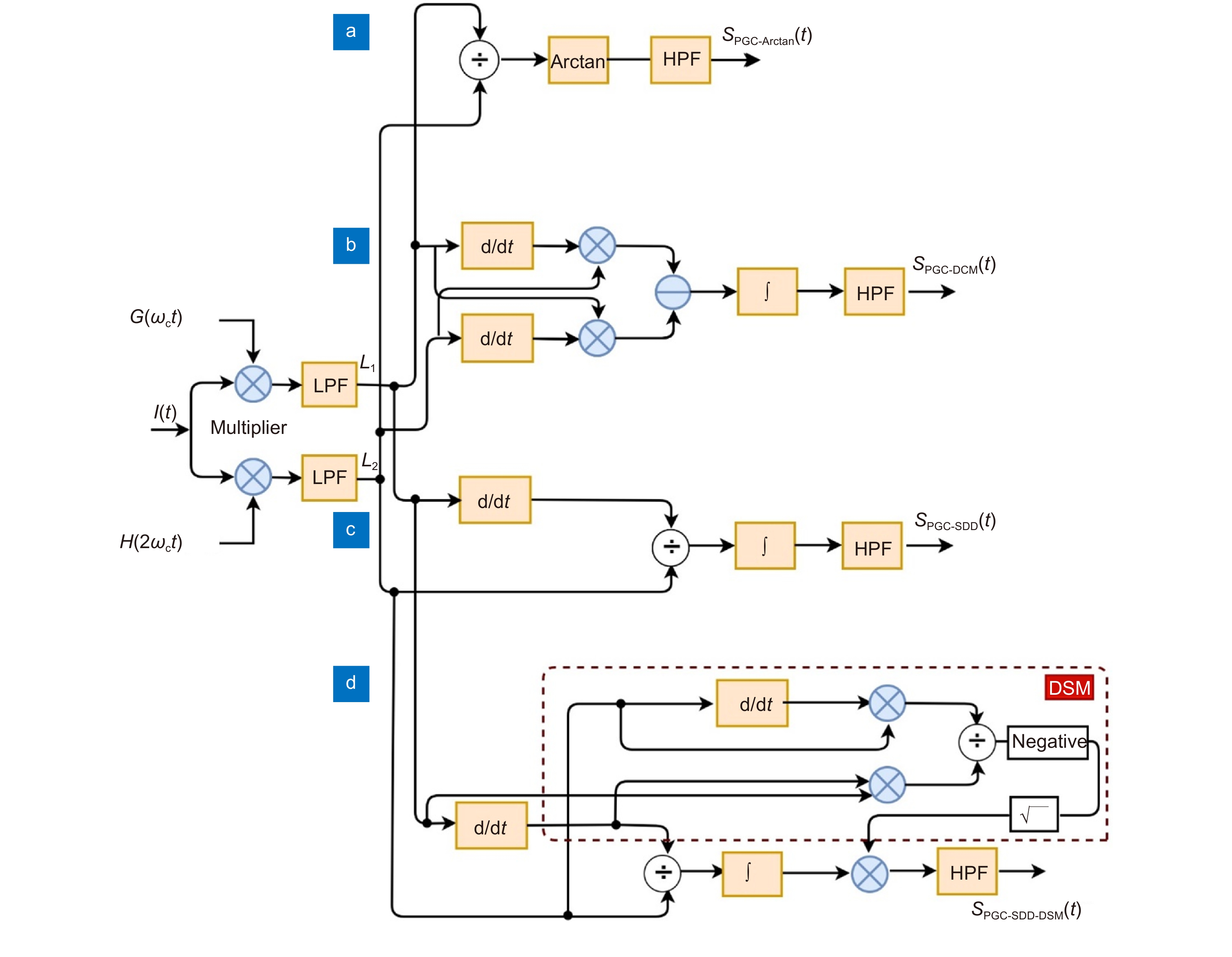
 下载:
下载:
